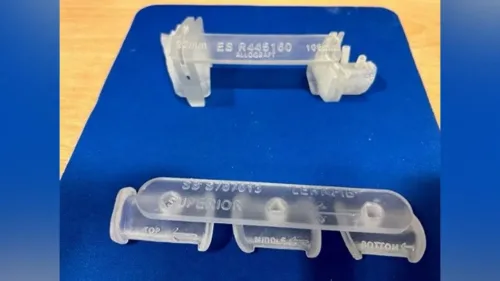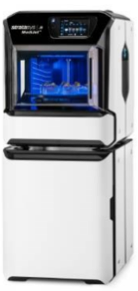Source: www.todaysmedicaldevelopments.com
Author: Elizabeth Engler Modic

3D printing enables virtual surgical planning, enabling surgery predictions and a better transplant fit for the patient.
CREDIT: Business Wire
The University Hospital Birmingham in England is delivering improved outcomes for head and neck cancer patients, with the hospital reporting reduced surgery times of up to three hours using tailored, 3D printed cutting guides.
This success is attributed to the integration of a Stratasys J5 MediJet 3D printer that enables the hospital to create highly accurate, patient-specific cutting guides ahead of operations, transforming the way tumors are removed from head and neck cancer patients. Previously, these would have been created by cutting and bending a piece of metal by hand while the patient was on the operating table, resulting in a time-consuming process with a large margin for error.
Using 3D printing, the surgical team can now produce highly accurate devices using patient scans, with a resolution of within 150 microns, helping to support surgical outcomes. These are produced in Biocompatible Clear MED610; a rigid, transparent resin suitable for applications requiring long-term contact (more than 30 days) with intact skin and limited contact (up to 24 hours) with tissue, bone, or mucosal membranes.
“In addition to saving up to three hours of surgery time, 3D printing also enables much better surgical planning,” says Stefan Edmondson, consultant clinical scientist (reconstructive science) at the hospital. “Using patient scans, the team can create 3D visualizations based on the distinct anatomy of each patient – and then leverage 3D printing technology to produce both anatomical models and personalized surgical cutting guides ahead of the actual operation.
“This capability means we can not only accurately predict the surgery before it’s done, but that we have the tools to ensure that the meticulous pre-surgical planning can be executed with the utmost precision,” Edmondson explains. “The surgical team is also much better prepared, and the patient is far more at ease, as we can talk through the process and expected outcomes prior to going into the operating theater,” he adds.
According to the hospital, taking a segment of a patient’s fibula and molding it into the exact shape and size to transplant into the target area within the head or neck, while ensuring bone tissue is kept alive, is a highly complex process in which 3D printing really demonstrates superior capabilities over conventional methods.
“In this scenario, if the angles you’re cutting at aren’t absolutely perfect, the bone won’t fit and there will be a higher tendency for the body to reject it, leading to significant discomfort for the patient,” Edmondson continues. “Thankfully, the 3D printed cutting guides are accurate to micron level, ensuring the fibula is cut to the best possible fit for our patients.”
Stratasys’ GrabCAD Print Software that works alongside this printer, has also proven to deliver additional benefits. Its ability to automatically build support material contributes to the overall end-to-end time saving facilitated by the 3D printing workflow.
A pioneer in using additive manufacturing for medical applications, University Hospital Birmingham has long-standing experience with various Stratasys 3D printers and technologies. The hospital’s multi-material, full color printer was acquired through Stratasys’ UK based reseller, Tri-Tech 3D.
“Stratasys is the gold standard of 3D printers – something that is exemplified in the J5 MediJet,” Edmondson adds. “Beyond its ability to produce highly accurate cutting guides and brilliantly vivid anatomic models that are biocompatible and sterilizable, it is really easy to use, which makes it a winner with our team.”
Launched in 2021, the J5 MediJet gives users the ability to create multi-material, full color prints in a single tray. Hosted in a single office-friendly platform, which reduces outsourcing costs or the need for multiple printers, the system is built to maximize reliability and simplify maintenance.


Leave A Comment
You must be logged in to post a comment.